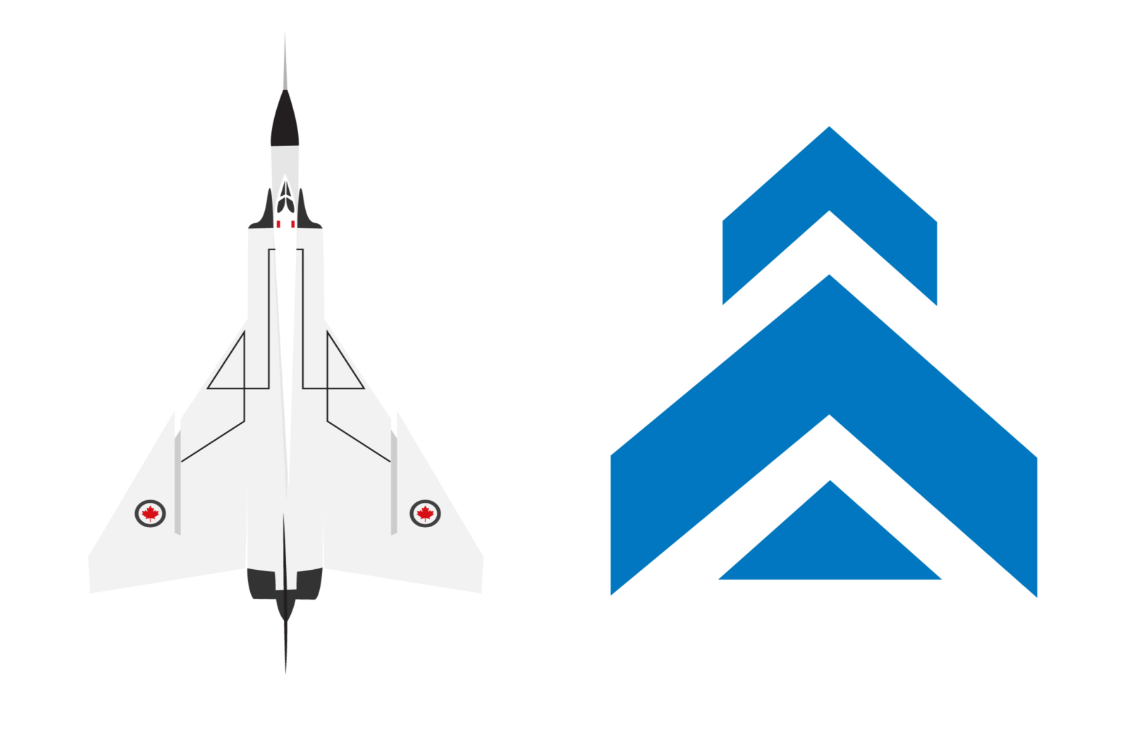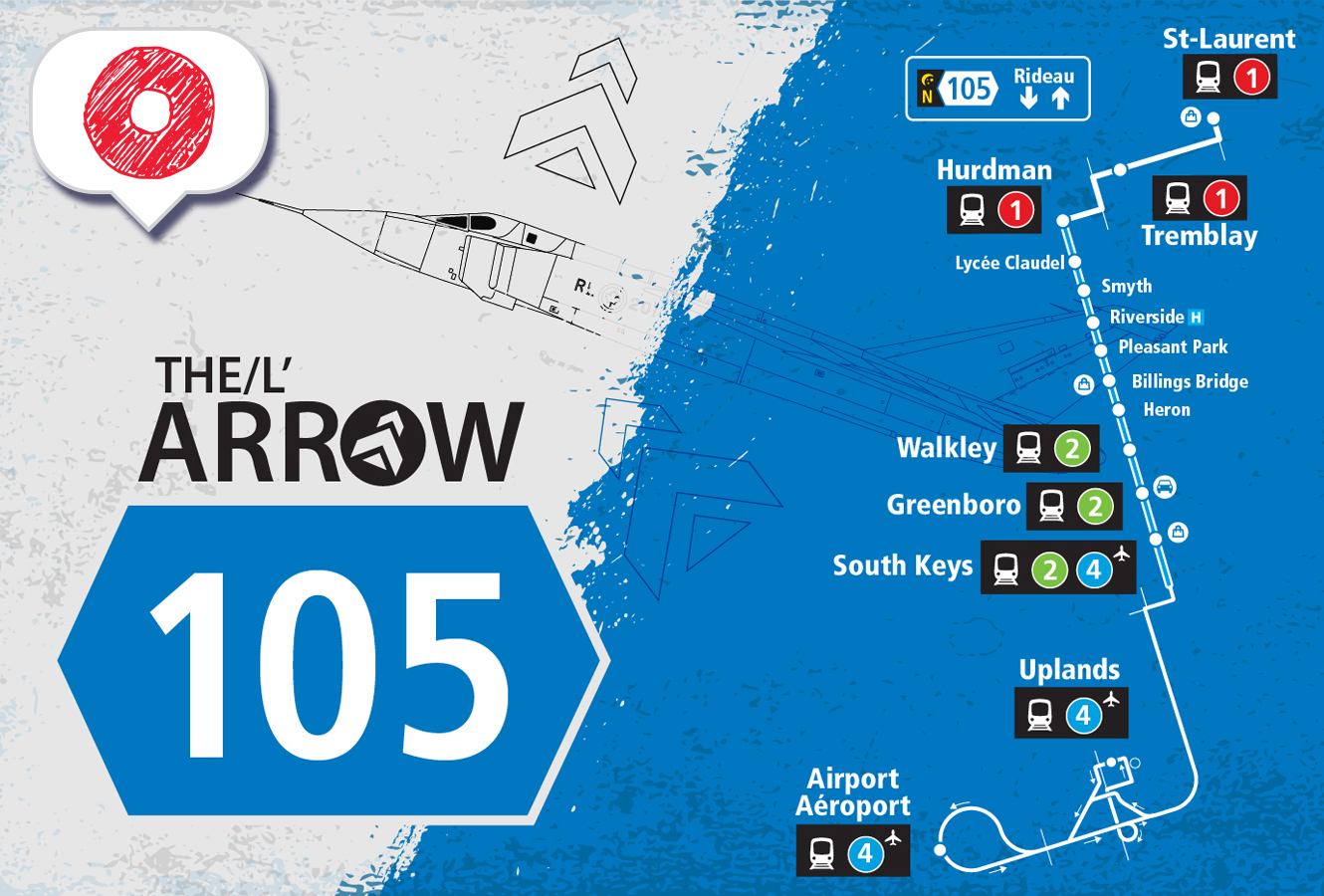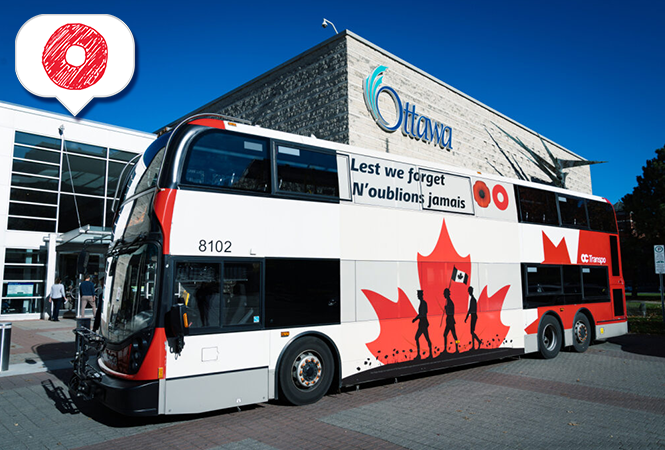✨ On August 24, we introduced Route 105Frequent Route, a new frequent route providing 24-hour bus service between the Ottawa International Airport and St-Laurent Station.
While route 105Frequent Route won’t travel at Mach 2 like its namesake, the Avro Canada CF-105 Arrow, this new bus route will improve travel times for many east-end customers travelling to and from the Airport.
The Next Stop Blog caught up with Dan, Program Manager of Operational Planning, to learn more about Route 105, how it got its name, and how we create new routes to respond to the changing travel needs of our city.
Creating a new route
It’s not every day that a new route is created.
New routes are typically introduced during a service change that takes place every winter, spring, summer, and fall.
“Scheduling at OC Transpo is an ongoing and continuous process. When planning new routes, one of the key inputs that helps inform our decisions is customer feedback submitted through our feedback forms.”
“Planning bus service begins months in advance and takes into consideration several factors, such as major events, operating conditions, new development areas, growth trends and feedback received throughout the year.”-Dan
While the New Ways to Bus network launched in April reflects extensive feedback collected through the 2023 Bus Route Review, Dan emphasizes that the transit planning process is ongoing as ridership patterns evolve and more customer feedback comes in.
“It’s not a closed door—we’re still listening and we’re still looking at ways to improve.”-Dan
With feedback showing a subset of customers traveling to the Airport wanted a more direct connection from the east end, staff explored potential solutions to improve the experience for riders making that east-to-south trip, and the new Route 105 was born.
What is Route 105Frequent Rout?
New Route 105Frequent Route offers more options for east-end residents accessing Airport and Uplands stations, with a direct connection from O-Train Line 1 and local bus routes at St-Laurent and Hurdman stations. The new route also provides a convenient connection between Ottawa International Airport and intercity buses and trains at St-Laurent and Tremblay stations.
Route 105Frequent Route operates 24 hours a day, 7 days a week, approximately every 30 minutes. Overnight, when O-Train Line 1 is not running, Route N105 connects to the Airport from Rideau and Hurdman stations. This new route is a direct link to the airport during the overnight hours when Line 4 is not in service. The new overnight service replaces Route N98, and the new service to the Airport replaces part of Route 197.
Why route number 105Frequent Route?
Every bus route has its own unique number. We choose these numbers to give information about when and where a route runs.
We assign route numbers to reflect the type of service:
Rail service is either 1, 2, 3, or 4.
Connexion Routes are in the 200s
Shopper Routes are in the 300s
Event Service to the Canadian Tire Centre is 400s
Event Service to TD Place is the 450s
School Routes are in the 600s
We also use the last two digits to help outline where in the city the route serves:
- 5–20 - Downtown
- 20s and 30s - Ottawa East and Orléans
- 40s - South-East Ottawa
- 50s - Ottawa West
- 60s - Kanata
- 70s - Barrhaven
- 80s - Nepean
- 90s - South Keys and Findlay Creek
And what about routes in the 100s and 110s? Dan says these numbers are typically assigned to routes that serve a “crosstown connector” function, connecting important points outside of the City’s centre, like the Airport and St-Laurent Station, without traversing the downtown “hub” of the transit network.
Aviation buffs may also recognize the route’s number as a tribute to the Avro Canada CF-105 Arrow, a supersonic aircraft and symbol of Canadian innovation. When the Transit Information and Marketing unit pitched the idea of a route number with an aeronautic tie-in, Dan’s team was eager to hear ideas.
“We’ve worked closely with the Airport, through New Ways to Bus and the launch of Line 4—they're a major stakeholder. And we know that Airport employees are a big percentage of the customers that we bring to the Airport. So finding new ways to link all the things that we do in a fun and progressive way is really exciting”-Dan
This was also a welcome opportunity to share OC Transpo’s playful side with fellow transportation fans.
“There’s a big overlap in transportation enthusiasts between the different modes: train, plane, bus. And I think that’s where a lot of my interest comes from—I come from a family of transportation enthusiasts.”
“At OC Transpo, we deal with a lot of important, and sometimes challenging situations, but it's also important to make time to show that OC Transpo can be fun, too.” Dan adds, noting that staff found inspiration in other cities: “If you take a look at other transit agencies, they find fun and creative ways to market their service to customers. Edmonton has Route 747 as their airport-to-train link. We want to come up with fun ways to market our service, too.”-Dan
Route 105Frequent Route is the latest local testament to the aircraft’s enduring legacy: Ottawa’s Aviation and Space Museum houses the largest collection of Avro Canada CF-105 Arrow components, and a roadway at the Ottawa International Airport bears the official name Avro Arrow Private.
Next stop: design
With the new route number ready for takeoff, the Transit Information and Marketing unit was tasked with branding our new Airport link. Taking Route 105Frequent Route supersonic nickname, “The Arrow,” staff developed an icon and wordmark fitting of the namesake.
The mission: Create an icon symbolizing the name and history of “The Arrow” that customers can easily recognize and form a lasting connection with.
The result is a clean, modern icon with three stacked arrows representing the nose, wings, and tail of the Avro CF-105 Arrow. The icon functions as a clear visual marker to denote the new bus service on maps, digital displays, and other communication channels.


As Route 105Frequent Route's journey shows, the process to launch a new bus route starts long before the wheels hit the road. OC Transpo’s Service Planning staff begin planning for quarterly service changes months in advance, considering customer feedback alongside other factors. As the plan takes shape, teams across the department work together to prepare customers, staff, and stakeholders for the upcoming changes.
And sometimes, in all that hard work, there’s an opportunity to have a little fun and squeeze in a Canadian Heritage Minute.


